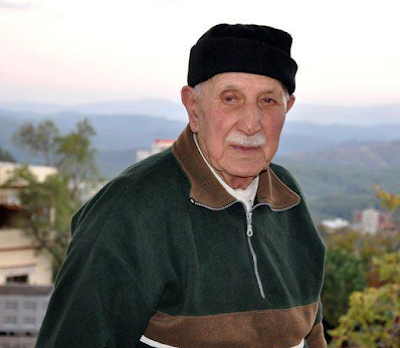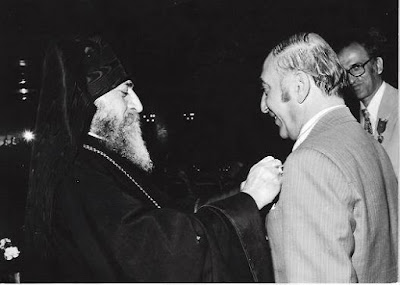V.H. Apelian's Blog

Tuesday, May 28, 2019
WHAT A DIFFERENCE A PICTURE MAKES !
Friday, May 24, 2019
THE UNSILENCEABLE BELFRY
Tuesday, May 14, 2019
Que Sera, Sera
 |
| LtoR: Hovhannes, Khacher, Zvart, Antranig, Karoun(Apelian), and Anna Chelebian |
Saturday, May 11, 2019
Մտային Շրջապտոյտը մը Քէորքիւնա
 |
| Քէորքիւնա, Գեսապ |
Այսօր եթէ ուզենք այցելել մեր սիրելի Քէօրքիւնան, իմ հարազատ և սիրելի անձիք բոլորն ալ պիտի ուզէի տեսնել հոն ուր որ վարժ էի տեսնել ...մեր տան ճամբուն վրայ ,կամ Գիւղին օձապտոյտ թաղերուն մէջ , Մայր ճամբու եզրին, առտուան կամ իրիկնամուտին, կէսօրուան տաքին և կամ մթագնած զով օդին։
Շատեր հոն են և կրնամ ինչպէս անցեալին բարևել, կատակել, բաժնեկցիլ...բայց այսօր խորհեցայ, երբ Սօնա Աբէլեան Բալուլեանի գուժը իմացայ, թէ այլևս պիտի չի կարենամ տանս ճամբուն վրայ տեսնել հրեշտականման սիրելի անձ մը, որ Աշօտ փեսային և իմ խօսակցութեան կը մասնակցէր երբ նկատէր որ Աշօտ փեսան խօսքը երկարեց ,խրատները վերյիշեցնել սկսա։ խօսքին կը միանար ուրիշ նիւթ մը սկսելով ժպիտը դէմքին և սիրալիր հրամմէ սուրճ մը շուրջ խօսեցէք ըսելով։
Աշօտ փեսան արդէն վաղուց դադրած էր խօսելէ և մեկնած անդիական։
Ալ պիտի չի հանդիպիմ Ճօրճ Չէլէպեանին իմ սիրելի ուղեկիցս, Տիւզաղաչի պարտէզէն վերադարձիս ,"հրամմէ սուրճ մը առ" պիտի չըսէ Խաթունը։ Շատոնց առ յաւետ հեռացած էին արդէն իմ մանկութեան հերոս չափահասները։
Չկան. եթէ յիշենք ուղակի ամայացած պիտի թուի ըլլալ գիւղս։
Ուրէ՞ Սիրվարդ Աբէլեան աղբրկէնը և իր սիրասուն վարդերը։
Ուր է՞ նուարդ Գէրպապեան Քոյրիկը կիրակի առաւօտ պաշտամունքի ձայնաւոր երգողը։
Ուրէ՞ Ճրճոս Գէրպապեան ամմին, որ երկար կը հնչէցնէր եկեղեցւոյ զանգը առանց գանգատի։
Ուրէ՞ Ստեփան Ամմին, (Պճճէյը), ժոզէֆ Գերպապեանը։
Երուանդ Աբէլեան ամմին որ զիս ամէն տեսնելուն անպայման պիտի յիշեր Հայրս, այլ Հմայակ մը պիտի ըսէր, և ապա աւելցնէր ըսելով "Գիւղի բարի մարդն էր հայրդ Ժօզէֆը"։
Արդէն ժոզէֆին կորուստը (Շէխին ) Յովհաննէս Աբէլեանէն շատ ուշ չէր։
Անշուշտ արդէն վաղուց մահկանացուն կնքած է Շէյխին Եղբայրը՝ Սողմոն Աբէլեանը (Մէնճօնը), Լոս Անճելըսի մէջ ուր կապրէր Վաթսունական թուականներէն, գաղթած էր Մորմոններու միջնորդութեամբ և կը պատմէր ախորժակով, մերթ թաւ պէպերը շոյելով որոնք կարծես իր Հօր Աբէլէն միակ ստացած ժառանգն էր։ Երբ Ամերիկա Ութա Նահանգը հասած են, Մորմոններու բնաշխարհը, խնդրած են որ մերմոնութիւնը դաւանի։ "Վէց գիր քաշեցի" Կաւելցնէր բարձրաձայն խնդալով երբ աչքերը չինացիներու աչքերուն պէս հազիւ ճեղք մը կը մնար նկատելի։
Զինք, շատ չանցած, պիտի հասնէր անդիական իր վէրջին եղբայրը Ասմար Խաչօն, մեր մանկութեան շատ քիչ թիւով վարիչներէն մէկը, որ հերոսացուցեր էինք մանաւանդ երբ "Ռամատանի" լուսնին նման հազուադէպ կերևէր միշտ ճամբորդած ըլլալուն պատճառով։
Եղբայրս կը խրատէր մեզի որ հեռու մնանք Օթօէն վատանգ կանխելու։ Ասմարն ալ միայն խեղճ Փիքափ մը թողուց ժառանգ ետին ...և Սուրիական Շարիայի օրէնքով նոյնիսկ ատիկա չկրցան ստանալ կինը և երկու դուստրերը, այլ միակ ժառանգորդը նշանակուեցաւ իր, նախապէս մահացած բայց տոմարներուն մէջ տակաւին ողջ եղբայրը Լոս Անճելոսի, ամէնամօտ արուն ընտանիքին...Մենճօնը։ Ասմարին կինը խիստ բարկացած կը զարմանար"Ինչո՞ւ չեն մեռցնէր Մէնճօնը»։
Ենովք Պէտիրեանը չկար որ ձայն տար Հանգուցեալ Յակոբ Աբէլեան Ամմիին թղթախաղի հրաւիրելով։
Ուր է՞ Մուխթար Ճէյմս Աբէլեանը, մեր սիրելի դրկից Ամմին, որ առաւօտները Հայրս սուրճի կանչէր, իրենց տան բակի շուքին առաւօտեան սուրճը BBC լուրերու սփրած ժամուն։
Ուրէ՞ Փաշան, գիւղի Փաշան Ժօզէֆ Աբէլեանը որ հաւաքէր տղաքը տպըխով թռչուն որսալու աշնան առաջին անձրևէն անմիջապէս ետք։
Ոչ Աբէլեան Յակոբ Ամմին կայ ( Տօքթորենց )։Ոչ ալ կինը՝ Մարի Աղբրկէնը Տօքթորինց հարսը, ոչ ալ Էլիզ Ապլան կայ, ոչ ալ Մինաս Պապուկը, ոչ Պետիր Ամմին կայ ոչ ալ Պէտըրէն Հուօրսը։
Չալապա նանան շատոնց ճամբած էինք։
Հրանդ Աբէլեան Ամմին և իր թրաքթորը չկան։
Ոչ ալ Սառա լէլոն կայ։
Աղբրկէնը, չկայ, ոչ ալ Ասատուրը որ շատոնց բարձրաձայն թաղին միջին կը դասաւորէր Խնձորի սնտուկները։
Չկան նաւե Լիտիա Քէրմարրը և Նորիս պապուկը որոնք հաւատարիմ աղաւնիներու նման միշտ կողք կողքի էին, թաղուեցան շատ հեռու իրարմէխ։
Ամառները՝ Մկրտիչ Պապուկ Աբէլեանը և իր կինը՝ Սատիգա Նանան աղօթաժողովներու հաւատարիմ միշտ ներկաները, հազիւ թէ աղօթքի առիթ տրուէր, Գրիգոր Փեսան Գոնիալեանը և Մկրտիչ պապուկը խաչաձևմամբ կը սկսէին իրենց բարձրաձայն աղօթքները, յանգուցեալ Հաննա Վերապատուելիին աղօթաժողովները ճոխացնելով։
Չկան գիւղին ծերերը և չափահասները։
Չկան նաև երիտասարդներ՝ Կարօ Աբէլեանը , Խաչօ Աբէլեանը, Հրաչ Գերպապեանը. չկայ Նորա Չէլէպեանը, ոչ ալ Վաչէ Աբէլեանը , առանց մոռնալու Ալպերթ Աբէլեանը։ Ուրէ՞ (Ուէյնաքը), Տօքթրինց Ճօրճ Աբէլեանըը բարձրաձայն տանիքէն կանչեր դրացի Մուսան։
Չկան ալ վաղուց մեկնած՝ Մարի Ենովք Աբէլեանը, Կիւլ Գագուսեան Աբէլեանը, Թաղին Սուրբ Ստեփան Պապուկ Աբէլեանը և իր կինը՝ Սառա Նանան, ալ չեմ մոռնար Հագէմ պապուկը, Ֆէրտա նանան, Մարդա Չէլէպեանը, ոչ ալ Տիկ. Մարի Սարմազեանը (երեցկին) որ Քէօրքիւնացիէ մը աւելի քէօրքիւնացի էին ընտանեօք։
Բնաւ պիտի չուզէր Տիկին Մարին որ մոռնանք իր սիրելի Գարուն Քոյրիկը Գագուսեանը, և ոչ Չաւուշ պապուկը կամ սիրելի մայրը Կրէկսէն Իշգէնը, նա մանաւանդ բարեպաշտ Գագուսինց Սառի նանան, և իր ամուսինը՝ Յաւէտ լուռ Յովսէփ Քագուսեան պապուկը։
Անշուշտ Մուխթար Շահէ Աբէլեանը պիտի ըսէ հապա՞ իմ Մուխթար Ալպերթ Պապուկս և Էլիզար Նանան։
Իսկ եթէ քիչ մը իմ յիշեղութեանս վստահիմ տակաւին յստակ են մտքիս մէջ են Հագէմ Պէպոն, Մինաս Վերպիտը Չէլէպեանը՝ գիւղին որմնադիրները, Շամօ պապուկ՝ վարպետ ատախձագործը և իր կինը՝Մէնըշ Նանան, ոչ ալ Օսաննա քոյրիկը, Դանիէլ Ամմին։ Ամառները թթենիի շուքին տակ կը հաւաքուէին։ Թաղեցիք իրեն բարի եկարի Անուշ քոյրիկը և Պարգև Գերպապեանը որ առանց թռչունի որսորդութեան օր չէր անցնէր Քէօրքիւնա գտնուած շրջանին.
Անշուշտ յիշողութեանս մէջ են նաև Աբէլեան պապուկները՝ Հաբէլ Պապուկը, Ասատուր Պապուկը, Կէկուս պապուկը և իր կինը՝ Հիլանի նանան։ Դեռ շատ լաւ կը յիշեմ Մուխթար Նշան Աբէլեան պապուկը և մուխթարՆանան, իրենց հարազատ Թութիկ նանան և Յովսէփ պապուկն ու "Հուռմոն իշկէն" նանան,Նազիրան։
Այս բոլորը ունէին Աղայ մը, Ճէյմս Աղան որ Ամերիկայէն եկած էր, հայրը Հանգուցեալ Գրագէտ Գէւորգ Ճօրճ Աբէլեանին, որ իր հօր տարիքէն շատ աւելի վաղ կորսնցուցինք։
Ալպերթ Քեռիս գիւղին Պիրատարը, ուղղամիտ և բարի մարդ, տքնաջան աշխատանքի մարդը իր հօր նման երկարակեաց չեղաւ.
Այսպէս, գիւղս ամբողջ, լեցուն էր և շէն, իրիկնամուտին իւրաքանչիւր տան բակէն կը լսուէին ձայներ անասուններու, փոքրերու և մեծերու ,ամէն մարդ իր երդիքին տակ ամփոփուելու պահուն։
Նոյնիսկ տակաւին թարմ կը հնչեն անոնց ձայները ականջիս ...։ Բնաւ մոռցած չեմ Հօրս Սիրելի շպէնը, իրկը նշէնծուիրը Քիւքիւնէցիցը մեր Ճօզէֆ Ամմին որ նուռ մը անպայման ձեռքին, կամ նռնենիի մը շուրջ աչքերը վեր, լաւ նուռ մը կը փնտռէր։
Անշուշտ ամառը գիւղը ճոխ էր։ Փաշայենք եկած Պէյրութէն հեռուէն կը լսուէր Անուշ Քոյրիկին խնդուքը և ձայնը։ Իսկ Աղաւնի Աղբրկէնը, անդադար իր ցուցմունքները կու տար թաղի կիներուն։
Մանաւանդ Դայեակ Սառա նանարը, որ միևնոյն ատեն միակ բեկաբոյժը գիւղին երբ հեռաւոր գիւղերէն կուգային Քէօրքիւնա, Էբիլինց Տօթրէն օրերէն։ Հիմա կային հիւանդապահ Աղաւնինև Սառա նանան։
Ամառները կայցելէին Հօթէլ լիւքսէն Յովհաննէս Ամմին, Զուարթ Աղբրկէնը։ Երուզեր կար տունէ տուն այցելուները, ոմանք բարի գալուստի ոմանք բարի երթ մաղթելու։
Տակաւին չիջայ Աղբիւրը, Ֆրնճի Կարապետին քով սուրճ խմելու։ Ճամբան զիս պիտի կեցնէր (Գըժժո,) Ժօզէֆ Յովսէփեանը, հարցնելու թէ Ովսաննան (թալթամըզը) մեզի եկա՞ւ Սառա Նանայէն մածուն առնելու։
Այսպէս կանցնէր մեր օրերը անփոյթ և ուրախ։
Անշուշտ երբ կը յիշեմ մէկ առ մէկ, կուզէի քովս յուշող ալ ունենալ, թերևս Անգին մայրս եթէ մօտս ըլլար շատ պիտի օգնէր և ըսէր, հապա տղաս ինչպէ՞ս կըլլայ որ մեր Գէրօն լէլոն՝ Գարուն (Աբէլեան) Չէլէպեանը մոռցար։ Ան իր դաստիարակչական ակնարկութիւններով պիտի ըսէր ինծի, "Ստեփան, այդպէս երեսդ լուալ եղա՞ւ մը տղաս"։ Երբ առաւօտուն պատահէր զիս տեսնել մէկ ձեռքով երեսս լուալը, և ոչ Իր սիրելի զաւակը, որուն հետ միասին հասած կըլլային Պէյրութէն՝ Անդրանիկ Քեռին որ նախաճաշի սեղանին նստած աջ ու ձախ կը դարձնէր հացը ձեռքին մէջ վստսհ ըլլալու թէ թոնիրէն հողի փշրանք մը փակած չըլլայ իր ուտելիք հացին վրայ։
Ցաւով կուզեմ ընդունիլ որ Իմ շատ Սիրելի առաջին ուսուցչուհիս Սիրվարդ Չէլէպեանը վէրջիններէն մնաց յուշերուս մէջ, որզիս առանձին նկարած էր մանկութեանս Քաուչուկէ Ճիզմայով որ նկարս ունենայ երբ հարս երթայ Աւստրալիա Գարակուննինց Ժօզէֆին։ Ինչպէ՞ս չյիշել անոնց ամառնային որսորդութեան վայրս՝ Գարակուննինց այգին, Երբ երկար կրակէի յանկարծ Գարակուննին շատ կամաց, առանց ձայնի մօտենար ետիս և ըսէր, "Հիրէք ի օղլըմ վըրձ մէտուօք թող" (բաւարարէ տղաս, արու եւ էգ թռչուն մը ձգէ)։ Կը նայիմ, միշտ խաքի Քլօթ տաբատով և գլխուն Քասքէթ դրած այս մարդը եւ կը խորհիմ այս հագուստներով ալ կը պառկ՞։ "Հարթում Պէպօ հարթում" (կը մեկնիմ, կը մեկնին) կ՚ըսէի և թուփերուն մէջ որսացած թռչունս փնտռելու պատրուակով կը մտնէի։
Գարակուննին մեզի համար Քէօրքիւնայի Հարաւ Արևելքը առանձին տան մը մէջ բնակող քիչ մը անիրական անձ մըն էր որպէս երեխաներ։ Անոր համար ալ զարմացած էի որ Սիրելի ուսուցչուհիս ինչպէս առեղծուած ընտանիքին մէջ հարս պիտի երթայ։Բայց երբ Լիբանանի պատերազմէն փախած, բարեկամիս հետ միասին որոշեցինք Յորդանանի համակսարանը փոխադրուիլ, Կարպիս Հանէշեանը և ես Ամման Սիրվարդին և Ժօզէֆին տունը հիւրընկալուեցանք շատ ջերմօրէն և հոն քնացանք։ Տարիներու շփոթութեանս պատասխանը առած էի, հիմա գիտեմ ով էր Գարակուննին Ժօզէֆը։ Աստուած ողորմի Սիրվարդին և ժօզէֆին։
Երբ նորէն անդի թաղէն կ՚անցնիմ, Գարակուննիէն վերադարձին, կը յիշեմ Պաղցը Նանարը, Գագուսեան, Մեծ մօրս Սառա Նանարին սիրելի այցելուն, որ իր Հաննա զաւկին մասին միշտ պարծանքով էր։ Այդ համեստ մարդը, որ իր զաւակներով Պէյրութէն կուգար հսնգչելու իր պապենական տունը, միշտ կոկիկ հագուած իր դերձակի բծախնդրութեամբ։
 |
| Ստեփան եւ Արա Աբէլեան |
Wednesday, May 8, 2019
Nezar Khalili (1925 – 2019)
Vahe H. Apelian
 |
| Nezar Khalil |
Saturday, April 27, 2019
The KEA Evening School Gabriel Injejikian Founded - 2/2
 |
| Teachers and Kessab Education Association of Beirut Committee Members |
Monday, April 15, 2019
In memory of Gabriel Injejikian: "Gossip or It is What It Is"
 |
| 1974 in Beirut, with dignitaries when the Community Honoring Gabriel |
 |
| Yervant Barsoumian being honored by the Catholicos for his support as the Chairman of the committee for assisting Gabriel Injejikian |
 |
| 1974 in Beirut, the community honoring Gabriel Injejikian for his pioneering work. |








